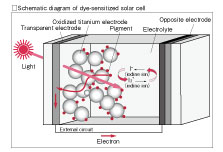Dye-sensitized solar cells can be produced with a shortened manufacturing process

Light is passed through a transparent electrode onto a pigment, the pigment absorbs light, and electricity is discharged to an oxidized titanium electrode. The electricity transmits to the transparent electrode, and returns to the opposite pole by way of an external circuit. The electricity receives an electrolytic iodine ion (oxidation) and is passed to the pigment (restored). Current is generated by the movement of this electricity.
Solar cells not-using silicon that utilize a photocatalytic function of oxidized titanium become possible to oxidize organic dyes to generate electricity. Because it is possible to fabricate solar cells by means of a simple process of coating and heat curing, research toward making this technology practicable is advancing.
Sharp has achieved the world's best conversion rate, 11.1% (achieved as the highest numerical score worldwide in verification testing by a public institution), and is leading research in the field.